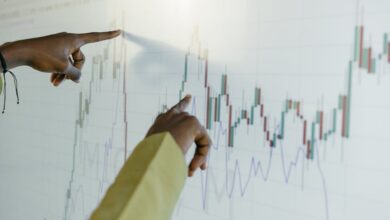Navigating Economic Storms: Early Warning Signs, Sector Impacts, and Strategies for Resilience During Recessions

As the global economy experiences cycles of growth and contraction, understanding the early warning signs of an impending recession becomes crucial for individuals, businesses, and policymakers alike. Recessions can reverberate through various sectors, affecting everything from consumer spending to international trade, and their impact is often felt long after the economic downturn has officially ended. This article explores the telltale indicators of a recession, the unique challenges faced by different industries, and effective investment strategies that can help navigate these turbulent waters. Additionally, we will examine the role of government stimulus in mitigating economic hardship, how consumer behavior shifts during downturns, and the implications for global trade and supply chains. Drawing on lessons from past recessions, we will highlight best practices for businesses to prepare for and survive in uncertain economic climates. Whether you are an investor looking to safeguard your portfolio or a business leader seeking resilience, understanding these dynamics is essential for thriving in the face of recession.
- 1. Identifying the Early Warning Signs: What to Watch for Before a Recession Hits
- 2. Navigating the Economic Downturn: Sector-Specific Impacts and Investment Strategies
- 3. Government Response and Consumer Behavior: Adapting to Recessionary Challenges
1. Identifying the Early Warning Signs: What to Watch for Before a Recession Hits
Identifying early warning signs of an impending recession is crucial for individuals, businesses, and policymakers to prepare and adapt effectively. Several key indicators can signal that an economic downturn may be on the horizon.
One of the primary indicators is a decline in consumer confidence. When consumers feel uncertain about their financial future, they tend to reduce spending, which can lead to decreased demand for goods and services. This shift often manifests in lower retail sales figures and can be tracked through consumer sentiment surveys.
Another significant warning sign is a decrease in business investment. Companies may scale back on capital expenditures, such as purchasing new equipment or expanding operations, in response to negative economic forecasts. A consistent drop in business investments can indicate that firms anticipate lower demand and are bracing for a slowdown.
Additionally, an inverted yield curve is a reliable predictor of recession. This phenomenon occurs when short-term interest rates exceed long-term rates, suggesting that investors expect economic growth to weaken in the near future. Historical data shows that inverted yield curves often precede economic downturns, making them a critical indicator to monitor.
Rising unemployment rates can also foreshadow a recession. An increase in job losses or a slowdown in hiring can signal that businesses are struggling, which often leads to reduced consumer spending and further economic contraction.
Lastly, monitoring key economic indicators such as GDP growth, manufacturing activity, and inflation rates can provide insight into the overall health of the economy. A consistent decline in GDP or manufacturing output, coupled with rising inflation, can create a precarious economic environment that is ripe for recession.
By keeping an eye on these early warning signs, individuals and businesses can better position themselves to navigate the challenges of an economic downturn.
2. Navigating the Economic Downturn: Sector-Specific Impacts and Investment Strategies
During an economic downturn, the effects on various sectors of the economy can vary significantly, influencing both consumer behavior and investment strategies. Understanding these sector-specific impacts is crucial for navigating a recession effectively.
The consumer discretionary sector often experiences the most pronounced declines during a recession, as individuals tighten their budgets and prioritize essential purchases over luxury items. Companies in this sector, such as retail and hospitality, may face reduced revenues, leading to layoffs and store closures. Conversely, sectors like consumer staples, healthcare, and utilities tend to be more resilient. These industries provide essential goods and services, making them attractive investment options during downturns.
Investors should consider reallocating their portfolios to include defensive stocks, which typically offer stable dividends and less volatility. For instance, companies in the healthcare sector, which provide necessary medical services and products, can serve as a safety net. Additionally, utility companies, known for their consistent demand even during economic hardships, usually maintain stable earnings and dividends.
Another sector that can present opportunities during a recession is technology, particularly firms that focus on efficiency and cost-saving solutions. As businesses look to streamline operations and reduce expenses, tech companies that provide automation tools and software can thrive. Moreover, the e-commerce sector often shows resilience as consumers shift to online shopping, making it a viable investment avenue.
Real estate can also provide mixed results during a recession. While commercial real estate may suffer due to increased vacancies, residential real estate—especially affordable housing—may remain stable, as people prioritize their living situations. Real estate investment trusts (REITs) focused on these areas can be appealing investments as they tend to offer dividends and can appreciate in value when the economy recovers.
In summary, navigating an economic downturn requires a nuanced understanding of how different sectors respond to recessionary pressures. By strategically investing in defensive stocks and sectors that demonstrate resilience, investors can protect their portfolios and potentially identify growth opportunities even in challenging economic climates.
3. Government Response and Consumer Behavior: Adapting to Recessionary Challenges
Governments play a crucial role in responding to economic recessions, often implementing a range of measures aimed at stabilizing the economy and supporting consumers. One of the primary tools at their disposal is fiscal stimulus, which can take the form of direct financial assistance, tax cuts, or increased government spending on infrastructure and social programs. Such measures are designed to boost consumer spending, stimulate demand, and ultimately foster economic recovery.
During a recession, consumer behavior often shifts significantly. As economic uncertainty rises, individuals tend to prioritize essential expenditures while cutting back on discretionary spending. This shift can result in a decrease in demand for non-essential goods and services, prompting businesses to adjust their strategies. Retailers may pivot towards offering discounts or promotions to attract budget-conscious consumers, while service industries might need to innovate or streamline operations to stay afloat.
Moreover, consumer sentiment plays a pivotal role in shaping economic outcomes during recessions. When people lack confidence in their financial stability, they are less likely to make significant purchases or investments. Government responses that reassure consumers—such as unemployment benefits or relief programs—can help to restore confidence and encourage spending, which is vital for economic recovery.
Additionally, during challenging economic times, the role of digital platforms and e-commerce becomes increasingly pronounced. Consumers may gravitate towards online shopping for convenience and better deals, prompting businesses to enhance their digital presence and adapt their marketing strategies accordingly.
In summary, the interplay between government responses and consumer behavior is critical in navigating the challenges posed by a recession. By implementing effective policies that support consumer confidence and adjust to changing spending patterns, governments can mitigate the impacts of economic downturns and pave the way for recovery.
In conclusion, understanding the early warning signs of an economic recession is crucial for individuals, businesses, and policymakers alike. By recognizing indicators such as declining consumer confidence, rising unemployment rates, and shifts in market dynamics, stakeholders can better prepare for the challenges that lie ahead. The varied impacts of recessions across different sectors highlight the importance of tailored investment strategies, enabling investors to navigate turbulent times more effectively.
Moreover, government stimulus plays a vital role in mitigating the adverse effects of economic downturns. By implementing targeted measures, governments can bolster consumer spending and support struggling industries, fostering a quicker recovery. As consumer behavior shifts in response to economic stress, businesses must remain agile, adapting their strategies to address changing needs and preferences.
The lessons gleaned from past recessions remind us of the cyclical nature of economies, underscoring the importance of resilience and proactive planning. Companies that prioritize financial health, diversify their offerings, and maintain a strong connection with their customers are better positioned to weather economic storms.
Ultimately, while recessions present significant challenges, they also offer opportunities for growth and innovation. By learning from history and implementing effective strategies, businesses and individuals can not only survive but thrive in the face of adversity, paving the way for a more robust economic future.





